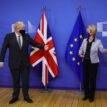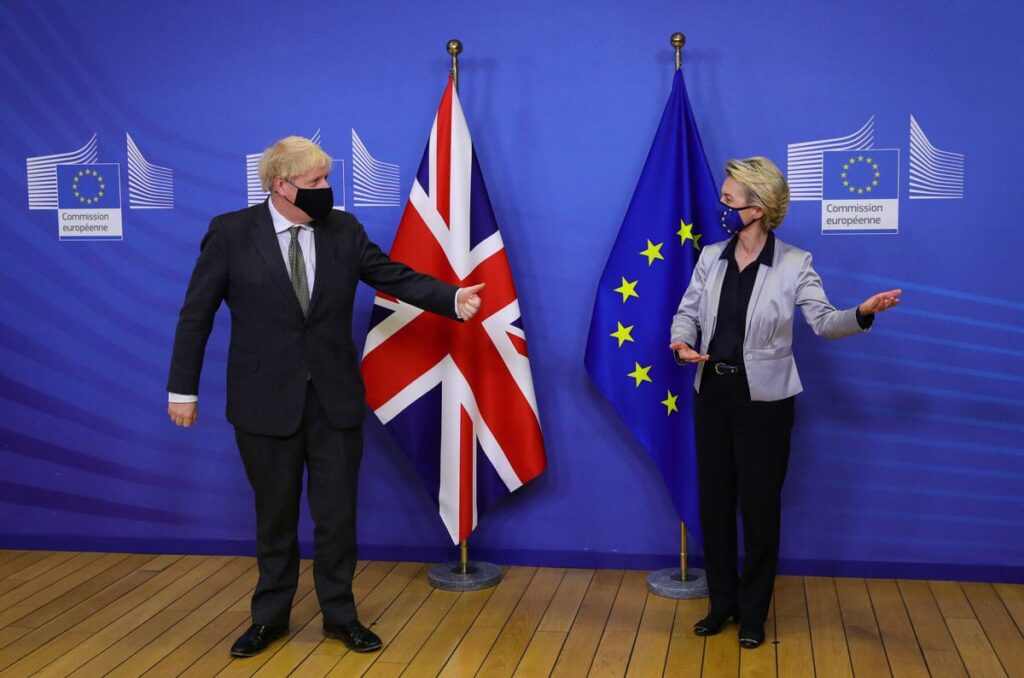

Despite enormous disagreements over the past years, the European Union and Britain breathed a collective sigh of relief on Thursday after finally managing to find common ground: A post-Brexit deal has been struck, they announced.
But what is the deal actually about? Here’s a breakdown of some of the most important points – including what happens next.
TRADE
While Britain officially leaves the EU’s single market, the agreement sets out that no tariffs and no quotas will be imposed on goods. However, customs checks will potentially delay processes at the border.
This applies to all goods that comply with rules of origin; this is to prevent products from third countries that do not have a free trade agreement with the EU from entering the bloc through Britain to circumvent tariffs and quotas.
TRAVEL
It will be up to Britain to determine whether EU citizens who come for short stays in the country will have to fulfil visa requirements.
“At present, the United Kingdom provides for visa-free travel for short-term visits in respect of nationals of all Member States,” according to the British government. The EU will continue to be treated as a bloc for visa purposes.
Short-term business travellers from Britain can visit the bloc for 90 days in any 180-day period, according to the British government.
Travellers – for example tourists – will still be covered by a mutual health care scheme in case of emergency.
ENVIRONMENTAL AND LABOUR STANDARDS
In the final agreement, neither side is bound by the other’s rules on environmental or social standards, but both have committed to general level playing field principles.
If one side feels the other is putting itself at an advantage by undercutting standards, it can appeal to an independent arbitration panel – crucially for the Brits, not the European Court of Justice (ECJ) – which can grant the right to impose sanctions.
According to the British government, the two sides agreed not to lower their labour standards for worker protection “in a manner that has an effect on trade.”
STATE AID
Both trading partners will have their independent subsidy rules – but if one side feels that the subsidies are distorting or harmful to its own industries, it can challenge those measures in front of an independent arbitration mechanism, with the possibility of compensation being imposed.
This has been a crucial point for the EU, which had been concerned that if Britain were to be granted free access to the bloc’s market, it could undermine competition if no strict subsidy standards were imposed.
FISH
This was one of the hardest parts of the deal, an EU official said, with negotiators poring over it “line by line, fish by fish.”
For a transition period until June 2026, the EU will retain 75 per cent of its fishing quotas in British waters, transferring a quarter to the British fishing industry. This big boost for the British side is worth 146 million pounds (198 million dollars) over five years, according to the British government.
From then on, there will be annual negotiations on catch quotas and access between Britain and the EU, as the bloc already does with some neighbours. The exact zones are up for discussion.
NORTHERN IRELAND
In order to avoid a hard border with EU member Republic of Ireland, neighbouring Northern Ireland will stay aligned with many EU standards when it leaves the bloc’s single market and customs union with the rest of the United Kingdom. This compromise eliminates the need for many checks at the Irish border and was worked out long before the trade deal. Most Northern Irish politicians welcomed the deal, but said they will need time to study it to assess the full ramifications.
NOT IN THE AGREEMENT
While the agreement is extensive – the legal text spans over 1,246 pages – some parts have been left out: Britain will not participate in the student exchange programme Erasmus, nor has a framework been agreed for cooperation on foreign policy or defence.
NEXT STEPS
On December 31, the post-Brexit transition period runs out, after which Britain will no longer be part of the bloc’s single market and customs union – but the agreement still needs to be ratified on both sides. London has called for a special parliamentary session on December 30. EU ambassadors discussed the deal on Friday, but the Council of the European Union still needs to unanimously agree to it.
The European Parliament also needs to sign off on it – and as that is likely to happen only next year, a provisional application is necessary. The European Commission suggests for that provisional period to run until February 28.
A rejection of the deal on any side is unlikely, however, given the stakes that are at play.
DPA
Vanguard News Nigeria
The post What’s the deal? The nuts and bolts of the new post-Brexit agreement appeared first on Vanguard News.






















0 Comments
Advertise your business here at cheap rate and get large audience to your market. Call/Msg Teemikemedia: 07060733664 to get started.